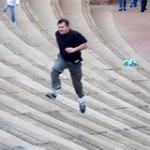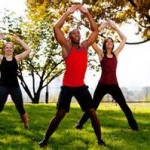Get Functional with Stairs!
Stair climbing is one of the most functional exercises. Think of how many times you may step up or step down during the day. Stair climbing strengthens your heart and lungs, your muscles, your balance, your agility and coordination. Start slow and easy after a proper walking or range of motion warm up of 8-10 minutes. Form is important when climbing stairs for exercise. Keep your upper body straight up, with your ears over your shoulders and your shoulders over your hips. Even though you’ll be looking down to insure safe stepping, focus on looking down with your eyes only rather than slouching your entire upper body forward and down. Ten stairs is a great repetition range to begin, followed by walking or marching in place to keep heart rate moderate during rest periods. Then, climb the next set of 10, and so on. So whether you revisit the classic stair climber machine at your gym or find a flight of stairs in your community, consider adding function to your fitness with this exercise.
*Consult your physician before performing exercise.
 Subscribe
Subscribe





